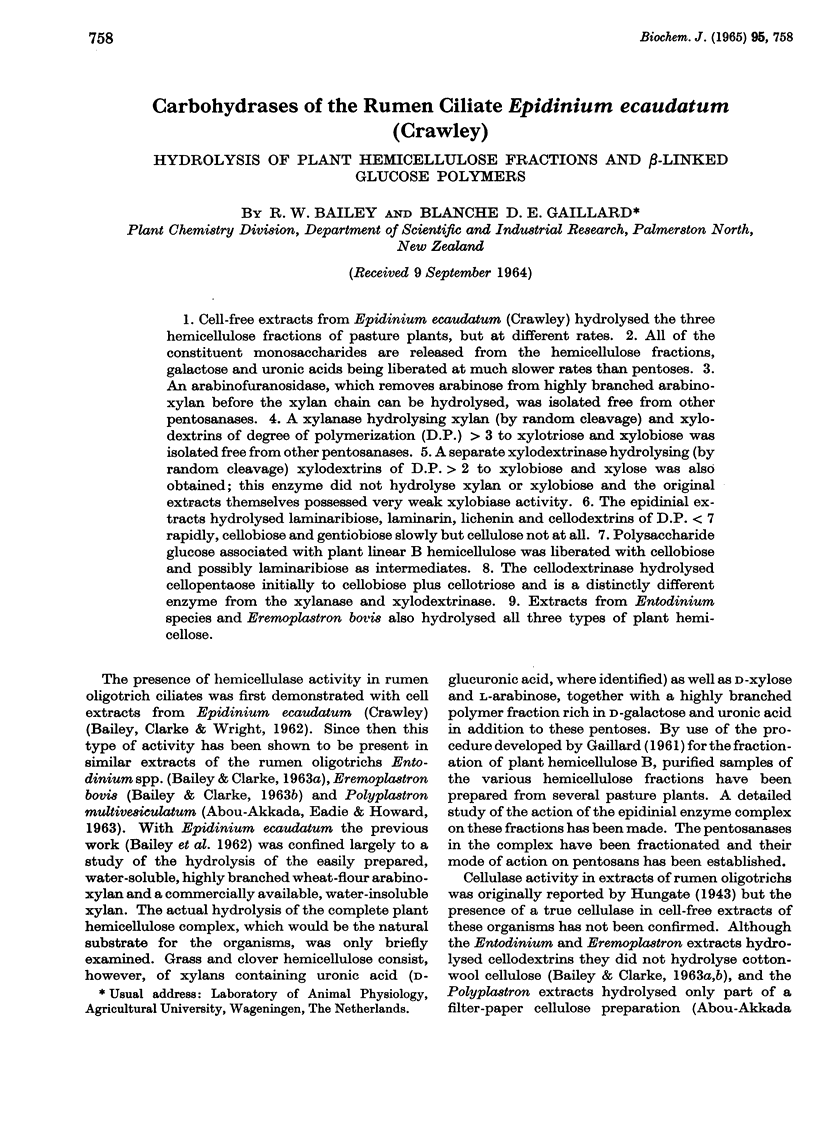Abstract
1. Cell-free extracts from Epidinium ecaudatum (Crawley) hydrolysed the three hemicellulose fractions of pasture plants, but at different rates. 2. All of the constituent monosaccharides are released from the hemicellulose fractions, galactose and uronic acids being liberated at much slower rates than pentoses. 3. An arabinofuranosidase, which removes arabinose from highly branched arabinoxylan before the xylan chain can be hydrolysed, was isolated free from other pentosanases. 4. A xylanase hydrolysing xylan (by random cleavage) and xylodextrins of degree of polymerization (D.P.) > 3 to xylotriose and xylobiose was isolated free from other pentosanases. 5. A separate xylodextrinase hydrolysing (by random cleavage) xylodextrins of D.P. > 2 to xylobiose and xylose was also obtained; this enzyme did not hydrolyse xylan or xylobiose and the original extracts themselves possessed very weak xylobiase activity. 6. The epidinial extracts hydrolysed laminaribiose, laminarin, lichenin and cellodextrins of D.P. < 7 rapidly, cellobiose and gentiobiose slowly but cellulose not at all. 7. Polysaccharide glucose associated with plant linear B hemicellulose was liberated with cellobiose and possibly laminaribiose as intermediates. 8. The cellodextrinase hydrolysed cellopentaose initially to cellobiose plus cellotriose and is a distinctly different enzyme from the xylanase and xylodextrinase. 9. Extracts from Entodinium species and Eremoplastron bovis also hydrolysed all three types of plant hemicellose.
Full text
PDF








Selected References
These references are in PubMed. This may not be the complete list of references from this article.
- AKKADA A. R., EADIE J. M., HOWARD B. H. THE BIOCHEMISTRY OF RUMEN PROTOZOA. 7. THE CARBOHYDRASES OF POLYPLASTRON MULTIVESICULATUM (DOGIEL & FEDOROWA). Biochem J. 1963 Nov;89:268–272. doi: 10.1042/bj0890268. [DOI] [PMC free article] [PubMed] [Google Scholar]
- BAILEY R. W., CLARKE R. T. CARBOHYDRASES OF THE RUMEN OLIGOTRICH EREMOPLASTRON BOVIS. Nature. 1963 Sep 28;199:1291–1292. doi: 10.1038/1991291b0. [DOI] [PubMed] [Google Scholar]
- BAILEY R. W., CLARKE R. T., WRIGHT D. E. Carbohydrases of the rumen ciliate Epidinium ecaudatum (Crawley). Biochem J. 1962 Jun;83:517–523. doi: 10.1042/bj0830517. [DOI] [PMC free article] [PubMed] [Google Scholar]
- BAILEY R. W., ROBERTON A. M. Carbohydrases of a rumen strain of Lactobacillus bifidus. 2. The intracellular alpha-1-6-glucosidase (isomaltodextrinase). Biochem J. 1962 Feb;82:272–277. doi: 10.1042/bj0820272. [DOI] [PMC free article] [PubMed] [Google Scholar]
- BAYLY R. J., BOURNE E. J. A new method for the paper chromatography of oligosaccharides. Nature. 1953 Feb 28;171(4348):385–387. doi: 10.1038/171385a0. [DOI] [PubMed] [Google Scholar]
- HOWARD B. H. Hydrolysis of the soluble pentosans of wheat flour and Rhodymenia pa'mata by ruminal micro-organisms. Biochem J. 1957 Dec;67(4):643–651. doi: 10.1042/bj0670643. [DOI] [PMC free article] [PubMed] [Google Scholar]
- HOWARD B. H., JONES G., PURDOM M. R. The pentosanases of some rumen bacteria. Biochem J. 1960 Jan;74:173–180. doi: 10.1042/bj0740173. [DOI] [PMC free article] [PubMed] [Google Scholar]
- MALPRESS F. H., HYTTEN F. E. The oligosaccharides of human milk. Biochem J. 1958 Apr;68(4):708–717. doi: 10.1042/bj0680708. [DOI] [PMC free article] [PubMed] [Google Scholar]
- TREVELYAN W. E., PROCTER D. P., HARRISON J. S. Detection of sugars on paper chromatograms. Nature. 1950 Sep 9;166(4219):444–445. doi: 10.1038/166444b0. [DOI] [PubMed] [Google Scholar]


